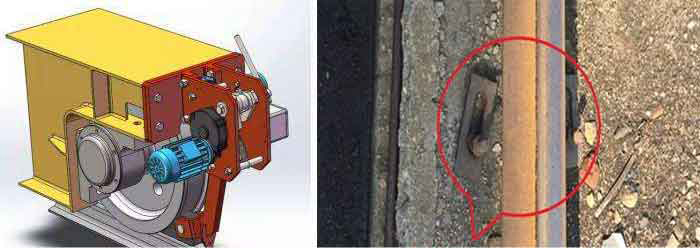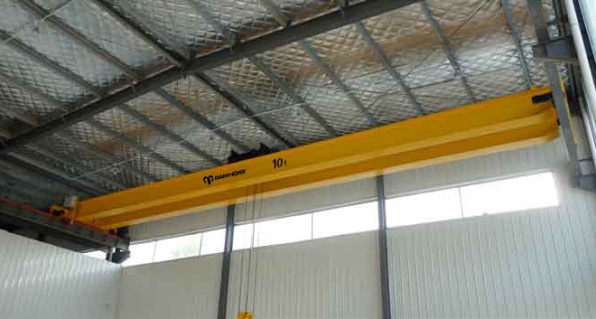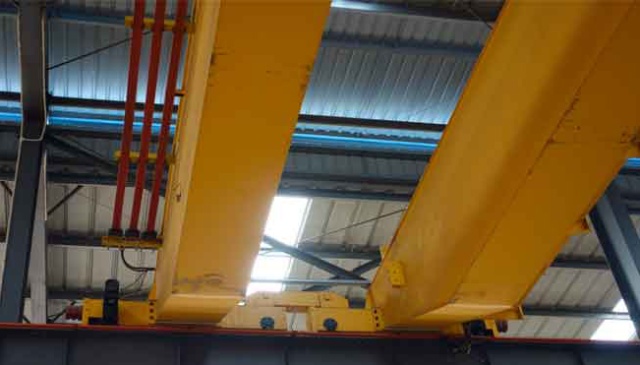
The reason of the rail gnawing on the wheel of a crane
Keyword:rail gnawing, crane Time:2018-11-30 8:16:40
Crane wheel problem, crane track problem, bridge problem and transmission system problems may cause crane wheel to gnaw rail. The following is the problem of rail gnawing on the rail.
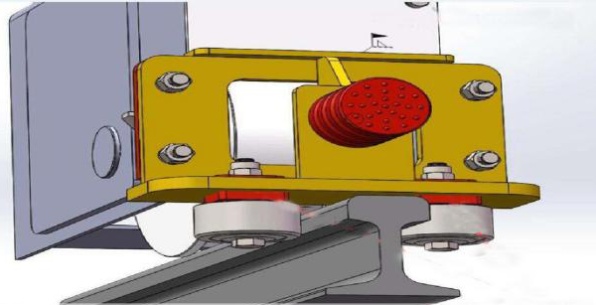
|
|
|
Wheel problem |
Rail problem |
|
|
|
|
Bridge problem |
Transmission system problem |
1, Wheel problem
The installation position of the crane wheels is inaccurate
One of the common reasons for wheel rail gnawing is that the horizontal line on both sides of the crane wheel is not the same. The main performance is that the lateral deviation is too large. The center line of the wheel rail surface of the crane and the center line of the track form an angle. In one direction, the crane will turn to the rail on one side of the wheel and rail. At this time, if the lift travels in the opposite direction, the rim and the rail on the other side will have an unstable position. The horizontal deviation should not be greater than L / 1000 (L is used to measure the length of the wheel) when the wheel is installed, and the direction of the skew on the coaxial line of the wheel should be opposite, otherwise the wheel will gnaw on the rail.
If the center of the end line of the wheel, the plumb line forms an angular wheel in the tilted state, the vertical deviation of the wheel will be too large. In this case, the contact area of the rolling wheel and the rail tread is reduced, and the pressure of the unit area increases, so the wear of the wheel rolling surface will be uneven and serious, and the ring wear is formed on the rolling surface of the wheel groove. In this way, the wheel is always gnawing on the same side of the rail, the wheel inclines, the rail gnawing tracks is slightly lower than the general condition, and the crane often hisse in the process. The vertical deviation of the wheel should be less than L / 400, and the upper part of the wheel should be on the wheel. The driving wheel is a gnaw tooth caused by vertical wheel rail, and has nothing to do with the passive wheel.
Other reasons that cause the wheel to gnaw the rail are wheel tread, diagonal range and two tracks on the same track. The rail and rail wear on both sides of the flange are the characteristics of these situations.
2, Error of wheel processing
In the process of wheel processing, it may lead to the error of the wheel, the diameter is in the two range. The main reason for the driving speed to make the wheel different is to drive the change of the wheel diameter. After a certain distance, the body will cause the O phenomenon to be caused by the tilt and lateral movement of the body. In particular, the F rail occlusion of the centralized driving mechanism.
3, Rail problem
The relative height deviation of two rails is too large due to the difference of the two sides of the ends of the overhead traveling crane caused by the relative elevation deviation of the two rails. In the course of operation, the crane will automatically tilt to the low side, causing skew. Side height of rail, lateral extrusion of rails and rail and low height of rail gnawing rail; lateral rail, flange and rail extrusion when rail gnawed.
The horizontal straightness deviation of the two rails is too large. When the rail line deviation, the rail straight, the horizontal bending of the rail are too large when the track is installed, when the tolerance range exceeds the tolerance range, the friction of the wheel flange and the rail side will be caused, and the skew will be produced.
The top surface adjacent to one side of the track is not on the same horizontal plane. When the crane is running at the track joint, there will be lateral movement of the vehicle, and there will be gnawing phenomenon. In this case, rail gnawing is often a metal hammer that hits the joint.
The top of the rail is oil, water and frost. If there is oil, water and frost on the track, it may cause the wheels to slip when running on the track, causing the car body to tilt and gnaw the rail.
4, Bridge problem
If the bridge is deformed, the deflection of the wheel and the span of the crane will change, and the end beam is flexed horizontally, which causes the horizontal deviation of the wheel, and the vertical deviation is too poor, which causes the wheel to gnaw on the rail.
5, Transmission system problem
The gear transmission system gap is not equal or the shaft key loosened. If the two gears are to be driven separately, when the gear gap is another group of gear gaps, or when a set of shaft keys looses, the speed range of the two drive wheels will be larger, and the vehicle will bite on the rail.
The two groups of brake tightness adjust the driving mechanism different. When starting and braking, if the brake clearance is larger, the brake clearance will be smaller on the other side, which will cause the trolley body to tilt and skew.
The rotation speed of the motor is too different. For the two sets of driving machines driven separately, because there is no connection between the two sets, if the speed difference between the two motors is too large, the side running speed of the crane will decrease during the operation, while the other side runs slowly, the body inclines to the left, and the rail gnawing the rail.
The phenomenon of rail biting will shorten the service life of wheel rail and reduce the service life of track, and damage the bearing structure. But "gnawing rail" is a common phenomenon in the use of cranes, so when the rail gnawing phenomenon occurs, it is necessary to analyze and deal with it in detail according to the actual situation. Ensuring normal production helps to reduce and avoid the serious impact of gnawing track on basic equipment and personal belts.
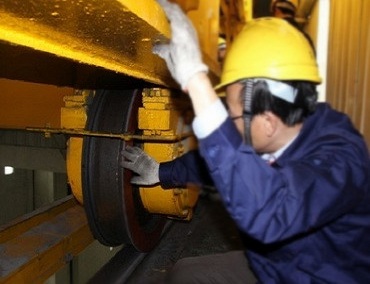
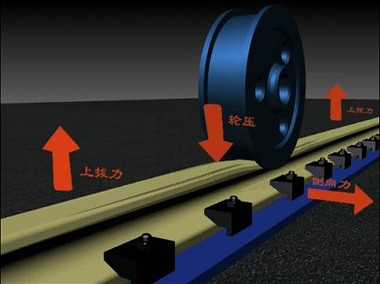

- No information
-
1. Design objective of electronic crane scale network management. (1) Adopt advanced distributed data processing techno…
-
Electronic crane scale bearing platform installation to focus Electronic crane scale can be installed generally on the li…



